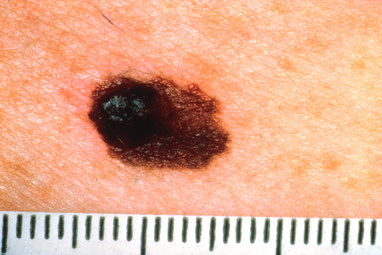May is skin cancer awareness month. It is also the start of warmer weather and sunnier days. This is the third and final blog post about sun and skin safety. Don’t forget to check out the first two.
There are three main types of skin cancer, depending on which cells are affected. Basal cell carcinoma, squamous cell carcinoma, and malignant melanoma.
Skin Safety Tip #5
Have your family doctor investigate any lesions you are concerned about.
- Early detection is important to allow for early diagnosis and treatment. But what are you supposed to look for?
Basal cell carcinoma (BCC) is the most common, affecting 50-60 000 Canadians every year. It appears most often in sun exposed areas of the skin (although can occur in non sun-exposed areas), most often on the face, head, and neck. It can appear in a number of ways:
- open sore that remains open for weeks
- shiny nodule that is most often pink, white, or red (may even have its own blood vessels)
- pink or red patch or growth
- tight scar-like areas
There are multiple treatment options. If untreated, however, BCC can invade local bone and tissue.
Squamous cell carcinoma (SCC) is the second most common form of skin cancer (around 20 000 Canadians affected each year). They most commonly appear on sun-exposed areas of the body. It can appear in a number of ways:
- wart-like growth with crust
- scaly red patch with irregular borders
- open sore that remains open for weeks
- an elevated growth with central indentation or depression
If detected and treated early, 95-98% can be cured. If left untreated, it can lead to disfigurement and can be fatal.
Malignant melanoma is the most rare, but most dangerous form of skin cancer. Over 5 000 Canadians are diagnosed each year, and over 900 Canadians die from melanoma each year. It is most often found on the backs of men and the legs of woman. Excessive UVR exposure, especially previous sunburns, have been attributed to the cause of melanoma.
For melanoma, follow the ABCDEs:

- A – Asymmetry – one side doesn’t match the other side
- B – Borders are irregular, notched, or blurred
- C – Colour is mixed within the same mole
- D – Diameter is larger than 6mm
- E – Evolving over time – any change (eg. size, shape, color, elevation, etc.)
For diagnosis, a biopsy of the lesion will be performed. The treatment will deppend on the stage and location of the melanoma.
Skin Safety Tip #6
Perform self-exams once a month
- Create a body map, keep a catalogue of all your freckles, moles, birthmarks, bumps, patches, etc.
- Here is a body map template (with instructions)
Don’t forget to check out our previous two blog posts on sun and skin safety for tips #1-4.
Resources
Harvard Health Publications
Skin Cancer Foundation
Canadian Skin Cancer Foundation
American Academy of Dermatology
National Council on Skin Cancer Prevention
American Cancer Society
Images
Asymmetrical Melanoma – by National Cancer Institute – CC BY

